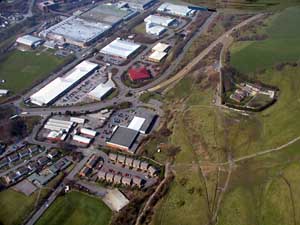Historic Landscape
Characterisation
Merthyr Tydfil
015 Taff Vale Industrial and Business Parks
HLCA 015 Taff Vale Industrial and Business Parks Recent
industrial/retail area built partly over former ironworks, associated
tips and related transport and water management features; site of associated
coal workings; site of ironworks settlement; post-war industrial architecture.
Click here for a
character area map
Summary
A 20th century industrial and retail area built over part of the site of the former Iron Works and Cinder Tips associated with the Plymouth Iron Company. Although the area contains an interesting example of the post-war industrial development, in the Hoover Factory, the main reclamation of the ironworks sites took place in 1974
Historical background
The historic landscape area of the Taff Vale Industrial and Business Parks comprises the valley base of the Taff. The area was formerly associated with the Plymouth Iron Works, founded in 1763 by Isaac Wilkinson and John Guest on land leased from the Earl Plymouth. The Plymouth Iron Works was sold in 1765 to Anthony Bacon following an initial lack of progress, and later control of the works fell to Richard Hill (d. 1806) in 1783. The works remained in the Hill family until the death of Anthony Hill in 1862, when bought by Messers Fothergill, Hankey and Bateman.
The Plymouth Works relied on water power, long after it had become obsolescent elsewhere and in order to re-use the water supply the works was forced to expand into three separate plants, the Pentrebach Forge and Dyffryn furnaces (see HLCA 015) being added. Steam power was finally introduced leading to a dramatic increase in output following the dry summers of 1843 and 1844. During the second half of the 19th century, obsolete technology and economics combined to the disadvantage of the Plymouth Iron Works. A lack of capital to convert to steel production finally lead to closure in 1880; though the company continued to mine its vast reserves of coal, from the South Dyffryn and other pits.
Two of the three Plymouth Ironworks sites: the Pentrebach Forge and Dyffryn furnaces were located within the area, on the west side of the Taff these were later additions to the works, set up after the creation of the Plymouth Forge Company in 1803. While the site of the Plymouth Works, the earliest works, lay to the northeast of the area (see HLCA 019). The remains of the ironworks were the subject of two large reclamation schemes undertaken during 1974.
From at least the early 19th century extensive cinder tips appeared in the area between the Plymouth Furnace and east bank of the Taff; from the c. 1820s the formerly wooded west bank of the Taff was also being tipped over, and both areas were linked to the Plymouth Ironworks by an extensive network of tramroads. The cinder tips were detailed for the first time in 1878, as was the Plymouth cinder bridge connecting the two tip areas. By 1878 this area contained a house called the Willows north of the cinder tips, later joined by a wire works, which was disused by 1905.
The area also included the site of the early 19th century ironworks settlement
of Upper Pentrebach, which comprised by 1850 the area known as the 'Triangle'.
By 1878, the settlement has a school, the Pentrebach School (endowed).
Characteristic features at this date were numerous allotments. Earlier
features remained, such as the Plymouth feeder and its associated weir,
and numerous industrial railways, including a tramroad, which crossed
from Abercanaid, via the Abercanaid Bridge, to the Pentrebach Ironworks.
Various industrial features were located along the eastern edge of the
area, such as engine houses, airshafts and magazines associated with the
coal and iron mines of the area. The area to the south of Pentrebach House
remained largely open agricultural land fronting the Taff Vale Railway.
Dyffryn Ironworks was also shown, including blast furnaces, engine house,
smithies, shafts and industrial tramroads. By 1919 the sites of the former
ironworks had been put to alternative uses: while a brickworks occupied
the site of the Pentrebach Ironworks, the Dyffryn Furnaces were now the
Dyffryn Boiler Works.
During the 1940s, the Hoover Factory was established, later expanding
to straddle the Taft like the earlier Plymouth tips. During the 1970s
much of the surrounding industrial landscape was reclaimed including the
Triangle and the Plymouth Works themselves, with much of the area subsequently
been given over light industrial and retail use.
